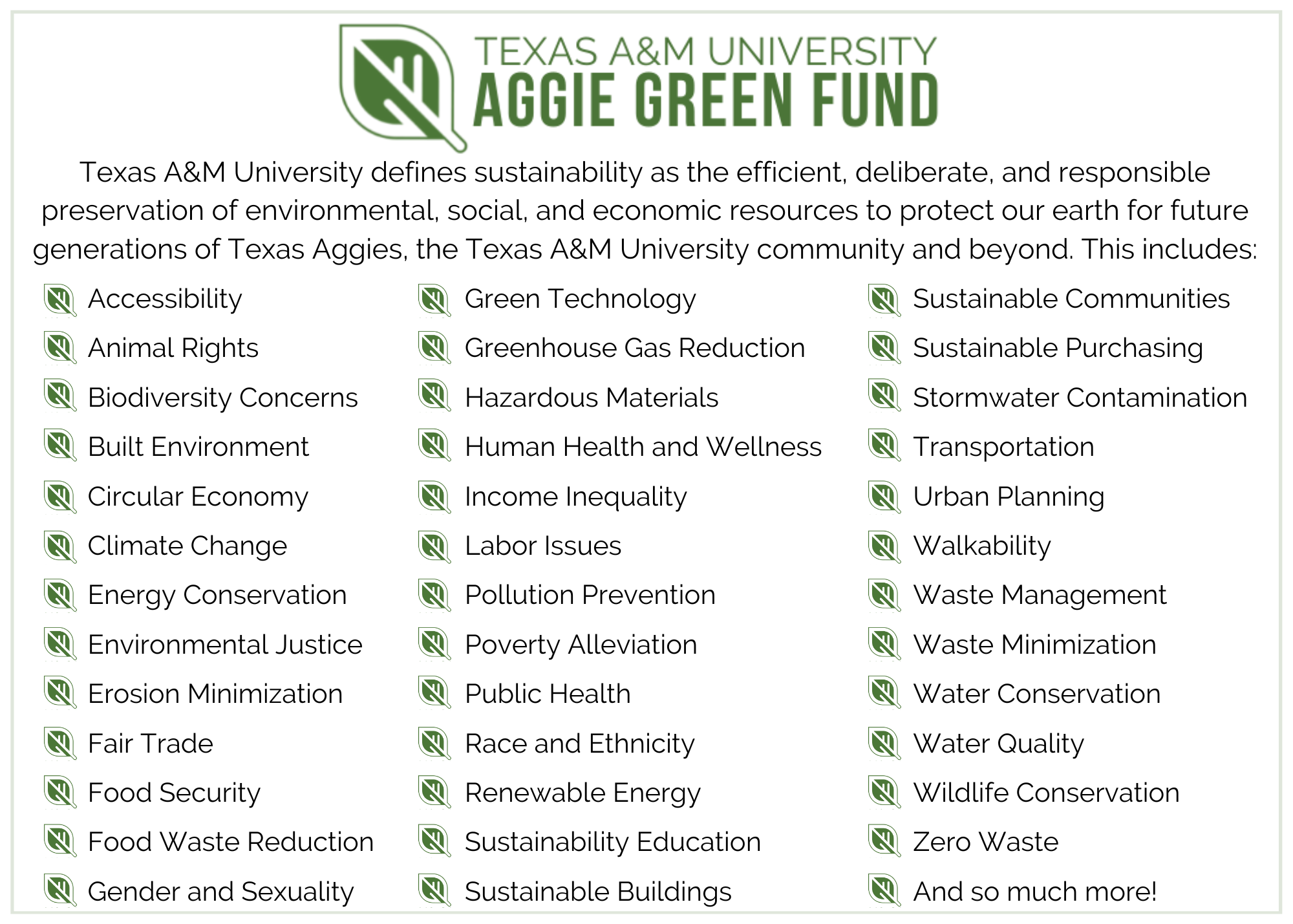GRANT OVERVIEW
The Aggie Green Fund (AGF) offers two types of grants: Major Grants and Micro-Grants. Major Grants undergo a two-stage application process and are approved once per year. Micro-Grants are limited to $3,500 or less, and projects must be completed within six months of fund disbursement. Micro-Grants are approved through a separate application process that is open September 14 to March 1.
The Aggie Green Fund Advisory Committee (AGFAC) welcomes and encourages all students, faculty, and staff with a great idea for sustainability improvements to campus to apply and get their idea funded. Applicants are encouraged to review all applicable information before beginning the application process. This includes the evaluation criteria below, Major Grant specific information, and Micro-Grant information.
Evaluation Criteria
To ensure consistency, accountability, and transparency in the evaluation and approval process, the AGFAC evaluates proposed projects on the following criteria. It is important to note that a high score does not guarantee project approval, and a low score does not disqualify a project from approval. Rather, the AGFAC uses the criteria as a guide when discussing and voting on the merits of a proposal.
- Concept (x9) - Is the project feasible, does it meet the below criteria, and will it contribute to Texas A&M in a significant manner? Is the idea innovative or creative? Does the project provide a tangible and measurable benefit to Texas A&M?
- Environmental Impact (x9) - Does the project positively impact the environment in a significant and measurable fashion (i.e. reduce waste or energy use, etc.)? Is the impact most felt in the long term or short term? Will the project positively, directly, and noticeably impact students, faculty, and staff on the Texas A&M campus?
- Social Impact (x9) – Does the project positively impact justice, equity, diversity, and inclusion on campus? For instance, does this project provide benefits to diverse campus populations? Does this project provide health and wellness benefits?
- Economic Impact (x9) - Does the project generate a positive return on investment, both as direct monetary costs and social costs? For example, will a $5,000 investment return $5,000 or more in benefits? Over how long of a time period are the benefits accrued? When are they most felt, in the near or long term? Does the proposal provide evidence of past projects to support its assertions? Does the project include costs that the university must bear once the project is implemented?
- Budget (x3) - Is the budget reasonable and well thought-out? Does it cover all costs, including direct costs (equipment, personnel, supplies, etc.) as well as indirect costs (office supplies, insurance, building costs, etc.)?
- Educational Benefits (x3) - Does the impact of the project provide a means to educate or inform students in sustainable practices and/or provide other academic gains?
- Evaluation/Follow-Up (x3) - Does the project have clearly defined and measurable goals, benchmarks toward success, and provide a clear means to attain them?
- Outreach/Publicity Plan (x3) - Does the project include a strategic outreach plan for students, faculty and administration? Is the concept one that is easily publicized, or is it highly complex? Will the benefits gained be easily demonstrated? How will the Aggie Green Fund Promotional Requirements be met?
- Innovation (x1) – Does the project identify a new solution to a sustainability challenge on campus? Does the project enhance an existing project in a substantial way (rather than a simple expansion)? Does the project provide a solution to a sustainability problem through engaging a new audience, experimenting with new processes, or by forming new partnerships?
- Capability of Project Team (x1) - Does the project team have previous experience or knowledge of the subject matter, have relevant connections to implement the project, and have project management and implementation skills? If the project is long-term, is there a means to ensure the project is maintained?
- Well Written Application (x1) - Is the application clear, consistent, and free of grammatical and spelling errors? Is the formatting professional, and does the overall appearance and style instill confidence for the project's success?
- Student Involvement (x1) - Does the project include students in key roles (i.e. planning, implementation, internships)? Will the proposed project impact students directly? Will students actively participate in the process of the project?

 TEXAS A&M UNIVERSITY
TEXAS A&M UNIVERSITY TEXAS A&M UNIVERSITY
TEXAS A&M UNIVERSITY